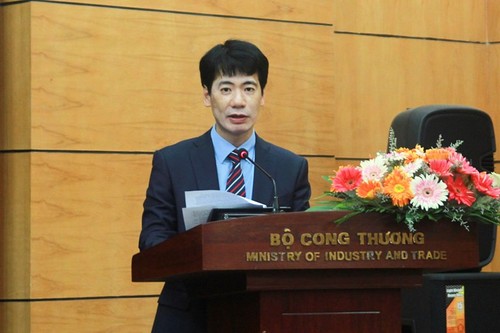 Ta Hoang Linh, Director of the European-American Market Department (Photo: hanoimoi.com.vn) Ta Hoang Linh, Director of the European-American Market Department (Photo: hanoimoi.com.vn) |
Last year, Vietnam fully tapped the FTAs it has signed with partners in Europe and the US including the Comprehensive and Progressive Trans-Pacific Partnership (CPTPP), the EU-Vietnam Free Trade Agreement (EVFTA), the UK-Vietnam Free Trade Agreement (UKVFTA), the Vietnam-Chile Trade Agreement, and the Vietnam-Eurasian Economic Union Free Trade Agreement (EAEU) which had a positive effect on Vietnamese trade and investment, especially exports.
Ta Hoang Linh, Director of the European-American Market Department, said that making full use of these FTAs will continue to be Vietnam’s priority this year.
“Our priority in the coming time is to keep a close eye on market fluctuations, propose cooperation frameworks and solutions to develop traditional markets and expand new potential markets. To that end, we’ll prioritize updating market information for businesses,” said Linh.
The Ministry of Industry and Trade will implement FTAs, especially new-generation FTAs like CPTPP, EVFTA, and UKVFTA.
This support will not only help businesses understand the commitments under these FTAs but also how to effectively apply their incentives, maximize their opportunities, and minimize their challenges.
“We’ll negotiate new FTAs with Mercosur countries including Brazil, Argentina, Uruguay, Venezuela, and Paraguay,” Linh added.
 Luong Hoang Thai, Director of the Multilateral Trade Policy Department (Photo: moit.gov.vn) Luong Hoang Thai, Director of the Multilateral Trade Policy Department (Photo: moit.gov.vn) |
According to Luong Hoang Thai, Director of the Multilateral Trade Policy Department of the Ministry of Industry and Trade, Vietnam's exports to FTA partner countries have grown rapidly in recent years.
In 2022, export turnover between Vietnam and CPTPP members grew more than 30%. Vietnam's export turnover to the European Union and the UK increased 20%.
The Regional Comprehensive Economic Partnership (RCEP) is expected to bring long-term benefits by establishing stable export markets for Vietnamese goods, said Thai.
“We have comprehensively implemented the signed agreements, with special attention to the markets that we haven’t been able to penetrate so far,” said Thai, adding, “We should also boost domestic production and make the most of the markets which have potential in technology, logistics, or other fields. We are getting closer to concluding the negotiation of an FTA with Israel, thereby entering the Middle East market,” said Thai.
Vietnam's exports to FTA markets account for about 2%, and the market share which Vietnam has obtained through tariffs and the origin of goods is 34% of that 2%. This means that room to increase Vietnam’s export is still very great.
Phan Van Chinh, Director of the Import-Export Department of the Ministry of Industry and Trade, called on businesses to restructure their production, improve the value of their products, and reduce logistics costs to take full advantage of FTAs.
He cited a World Bank report as saying, Vietnam’s logistics costs account for 20% to 25% in import, export and other commercial activities. If the costs can be reduced 5%, businesses can save a lot.
“According to a new Government decree, the Ministry of Industry and Trade is outlining a strategy for logistics development to serve imports and exports and other activities for the national economy,” said Chinh.
Vietnam’s negotiation, signing, and implementation of FTAs currently focus on growing sustainably and taking advantage of relations with FTA members to develop breakthrough industries in line with international trends, such as green technology, electronics technology, and the biochemical and pharmaceutical industries, and closely linked with regional and global supply chains.